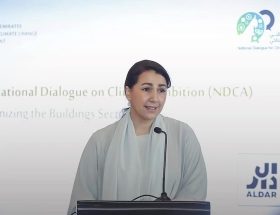Companies around the world are increasingly committing to climate change mitigation, pledging to reduce carbon emissions and water consumption across their operations and supply chains in an effort to slow the pace of global warming and better protect environmental ecosystems. However, while essential, these efforts merely prevent a worse future rather than addressing the inevitable consequences of the damage already baked in. Carbon offsets, for example, have yet to demonstrate meaningful impact on the atmosphere, and, at present, worldwide carbon sequestration efforts reportedly only remove 1% of annual global emissions.
We therefore believe that climate adaptation — helping people, animals, and plants to survive despite rising climate volatility — should be an equally urgent priority. According to a 2021 report from the Climate Policy Initiative, these types of initiatives receive only 7% of climate-related investment, allocated across a vast spectrum of needs such as flood and wildfire prevention, resilient agriculture, clean water supply, infrastructure modification, and population resettlement. They deserve far greater business investment, especially because they represent near-term opportunities at lower capital expenditures that offer faster paybacks. Indeed, according to this Bloomberg report, Bank of America analysts estimate that the climate adaptation market could be worth $2 trillion a year within the next five years.
Fundamentally, climate adaptation is about evolving organizational and institutional practices and infrastructures and technologies in places that most need them — which is everywhere that faces risks such as floods and rising sea levels, droughts, and heat waves. We advocate for solutions that are low cost, proven to be effective, and have immediate impact, such as early warning systems for extreme weather events, coastal barriers, water desalination and wastewater treatment, vertical farming and hydroponic agriculture, improved cooling and insulation systems, 3D printed and modular housing, and many other measures.
The insurance conglomerate SwissRe warns that a global temperature rise of 3.2°C by 2050 would wipe 18% from global GDP. But, as a pair of OECD studies point out, widespread climate adaptation measures can have a positive impact on growth, especially in G-20 economies.
When governments, capital market investors, commercial lenders, and businesses from multinational corporations to small enterprises work together toward climate resilience, as well as mitigation, the result will be a stronger world economy. Some are already stepping up to do so. For example, the Coalition for Climate Resilient Investment (CCRI), an umbrella organization of more than 120 companies and other stakeholders representing more than $20 trillion in assets, have launched pilot projects focused on reinforcing infrastructure to withstand anticipated climate effects. We see notable positive developments in other areas as well. Here, we’ll explore projects in water and agriculture and in construction and real estate.
Water and Agriculture
Water scarcity is already a short-term crisis and an even greater long-term challenge that even the most robust mitigation initiatives cannot immediately address. Water is the biggest and most important input for human life and global agriculture and is thus essential for our health, sustenance, and productivity, and yet many heavily populated geographies are already stricken by shortages.
Some of the most affordable water-related adaptation interventions involve rainwater harvesting and more efficient irrigation techniques. As countries invest in cloud seeding to spur rainfall, plant drought-resistant seeds, and deploy atmospheric water capture systems, conserving water for agriculture is an obvious complementary effort. London-based engineering consultancy Arup (which reports nearly $2 billion in annual revenue) has been ahead of the curve in carrying out flood control projects that increase natural water retention in Poland and flood alleviation schemes in England. Rainwater harvesting projects now represent a 5% and growing share of the portfolio of Kingspan, a leading Irish construction company whose low-energy insulation systems are featured in Bloomberg’s London headquarters and Singapore’s Changi airport. The city of Sydney, which has suffered consistent droughts with dams falling to record low capacity, has commissioned Kingspan to audit all 48 of the city’s rainwater management systems.
There are also signs of progress in developing countries. Israeli firm Netafim (a $1 billion revenue company) has installed irrigation systems across more than 100 villages in India, using soil and plant data to direct measured doses of water to optimize yield while bringing down water consumption and fertilizer usage by 40%. Olam, one of the world’s largest agri-business producers of rice, cotton, cocoa beans, and coffee that operates in 60 countries, is committing to reduce wastewater in the 30% of its upstream farms and plantations that are in water-stressed regions.
The economic benefits of water conservation include saving money on water purchases, storage, and maintenance, all of which accrue to corporations and villagers alike. Particularly in regions such as India, where only 10% of potential water-saving measures have been implemented, these kind of adaptation efforts deserve significantly greater investment and scaling.
Clean water generation is another essential and growing business opportunity. Existing desalination systems are often oil- or gas-powered and use a lot of energy. By contrast, Elemental Watermakers’ solar-powered reverse osmosis system uses the natural force of gravity to receive and clean pressurized seawater and is compact and mobile enough to be deployed in industrial sites and residential communities. One of its customers in Aruba has reduced water costs by 67% and carbon emissions by 180 tons per year. Another company, Terraformation, meanwhile operates what might be the largest full-scale, purely solar-powered water desalination plant on a 45-acre reforestation project site in Hawaii. However, similar ventures remain woefully underfunded despite their regenerative potential for ecosystems and local economies. Perhaps the most high-potential innovation would be nuclear-powered desalination, which would have enormous applications worldwide.
A steady and efficiently managed water supply would also support more environmentally friendly agriculture such as hydro- and aquaponic food production. China’s Sananbio, for example, operates large indoor farms in Beijing that can produce about six tons of leafy greens daily using only 5,000 square meters of space. Its plants absorb 60% of the water used, while the remaining 40% is recycled. Small and strategically vulnerable countries such as Israel, the United Arab Emirates, and Singapore have become leaders in this kind of food production, and it could greatly benefit many other water-stressed geographies.
Construction and Real Estate
Our built environment is a major driver of climate change and must also be a key front in adaptation. Because of their fixed location, real estate assets — valued at $200 trillion worldwide — are uniquely vulnerable to natural disasters and resource shortages. And many opportunities lie at the intersection of geography and technology. For example, from the Netherlands to Denmark and the Maldives to Singapore, developers and localities are planning or building floating cities that can rise with the tides and desalinate and recycle water for hydroponic agriculture.
Astro Teller, director of the Google X Lab, suggests that we might also one day need “movable cities” to cope with climate effects. As a first step, companies like ICON are creating 3D-printed houses. Its Vulcan construction system can deliver homes and structures up to 3,000 square ft that meet the requirements of the International Building Code (IBC) and are expected to last as long or longer than standard Concrete Masonry Unit (CMU), making them more resilient to extreme weather. They’re the first of their kind to be sold in the United States and the firm, currently valued at around $2 billion, is working with leading U.S. home-builder Lennar to construct a community of entirely 3D-printed homes in Austin. In both Mexico and the United States, ICON is also building entire communities of 3D-printed homes, barracks for those who serve, and a simulated Martian habitat for NASA.
Similarly, Boklok produces flat-pack homes designed and built by Skanska and sold at Ikea. The houses are primarily made of wood sustainably sourced from Scandinavia because of its relatively lower climate impact, and about 14,000 of them have been erected across Sweden, Finland, Norway, and the United Kingdom, generating $250 million in revenue for the adaptation-focused manufacturer.
According to UN Habitat, at least three billion people will require better housing by the end of this decade, which means that 96,000 new homes need to be built each day between now and then. Eventually, rather than building these habitats where people are, we will need to start moving certain populations to geographies less damaged by climate change, at lower risk of future effects, and with better resources and technology. Rising fire and flood insurance premiums, as well as chronic droughts and heatwaves, make this all but inevitable.
Our own Climate Alpha research suggests that investing early in climate-resilient geographies will generate more than 70% higher returns on real estate portfolios by 2030 alone. Property developers, asset managers, and insurers should take heed, accelerating the acquisition of land, construction of affordable housing, and adjustment of premiums to anticipate, encourage, and profit from climate-induced migrations. New technologies should help us to do this with speed. Consider the U.S.-based company Alquist, which can now print a three-bedroom home in just over 24 hours versus the typical four weeks that the volunteer-powered nonprofit Habitat for Humanity takes to construct one.
Addressing climate change requires both mitigation and adaptation, and we believe the latter represents an even better business opportunity. As we learned from Charles Darwin, those who adapt are the most likely to survive and thrive. Small investments result in significant preparation for an unpredictable future.
Original Article: Harvard Business Review by Ravi Chidambaram and Parag Khanna










